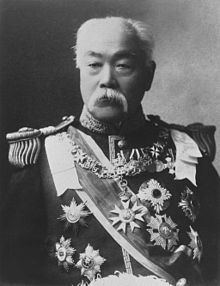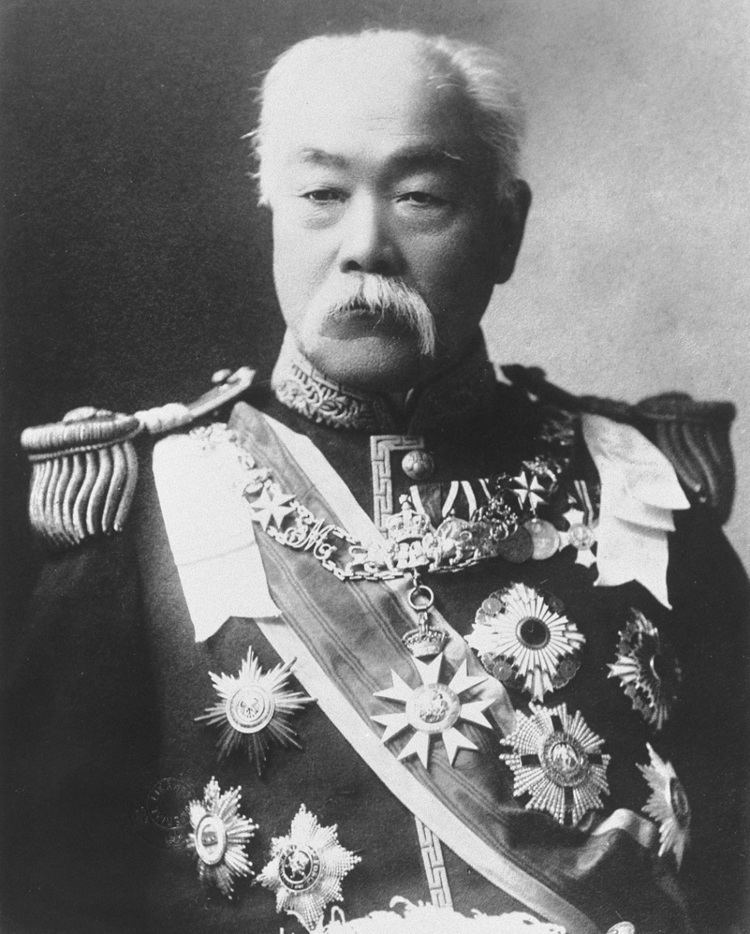Religion Shintoism Children Kojiro Matsukata Spouse(s) Matsukata Masako Succeeded by Ito Hirobumi | Monarch Meiji Name Matsukata Masayoshi | |
 | ||
Born February 25, 1835Kagoshima, Satsuma domain (now Japan) ( 1835-02-25 ) Books Report on the Post-Bellum Financial Administration in Japan: 1896-1900 | ||
Prince Matsukata Masayoshi (松方 正義, February 25, 1835 – July 2, 1924) was a Japanese politician and the 4th (May 6, 1891 – August 8, 1892) and 6th (September 18, 1896 – January 12, 1898) Prime Minister of Japan.
Contents
- Early life
- Financial reform
- Prime minister
- Later life
- Honours and decorations
- Titles
- Decorations
- Honorary degrees
- Personal life and relatives
- References

Early life
Matsukata was born into a samurai family in Kagoshima, Satsuma Province (present-day Kagoshima Prefecture). At the age of 13, he entered the Zoshikan, the Satsuma domain's Confucian academy, where he studied the teachings of Wang Yangming, which stressed loyalty to the Emperor. He started his career as a bureaucrat of the Satsuma Domain. In 1866, he was sent to Nagasaki to study western science, mathematics and surveying. Matsukata was highly regarded by Ōkubo Toshimichi and Saigō Takamori, who used him as their liaison between Kyoto and the domain government in Kagoshima.
Knowing that war was coming between Satsuma and the Tokugawa, Matsukata purchased a ship available in Nagasaki for use in the coming conflict. This ship was then given the name Kasuga. The leaders of Satsuma felt the ship was best used as cargo vessel and so Matsukata resigned his position as captain of the ship he had purchased. Just a few months later the Kasuga did become a warship and it fought in the Boshin War against the Tokugawa ships. At the time of the Meiji Restoration, he helped maintain order in Nagasaki after the collapse of the Tokugawa bakufu. In 1868, Matsukata was appointed governor of Hita Prefecture (part of present-day Ōita Prefecture) by his friend Okubo who was the powerful minister of the interior for the new Meiji government.
As governor Matsukata instituted a number of reforms including road building, starting the port of Beppu, and building a successful orphanage. His ability as an administrator was noted in Tokyo and after two years he was summoned to the capital.
Financial reform
Matsukata moved to Tokyo in 1871 and began work on drafting laws for the Land Tax Reform of 1873–1881.
Under the new system:
- a taxpayer paid taxes with money instead of rice
- taxes were calculated based on the price of estates, not the amount of the agricultural product produced, and
- tax rates were fixed at 3% of the value of estates and an estate holder was obliged to pay those taxes.
The new tax system was radically different from the traditional tax gathering system, which required taxes to be paid with rice varied according to location and the amount of rice produced. The new system took some years to be accepted by the Japanese people.
Matsukata became Lord Home Minister in 1880. In the following year, when Ōkuma Shigenobu was expelled in a political upheaval, he became Lord Finance Minister. The Japanese economy was in a crisis situation due to rampant inflation. Matsukata introduced a policy of fiscal restraint that resulted in what has come to be called the "Matsukata Deflation". The economy was eventually stabilized, but the resulting crash in commodity prices caused many smaller landholders to lose their fields to money-lending neighbors. Matsukata also established the Bank of Japan in 1882. When Itō Hirobumi was appointed the first modern-day Prime Minister of Japan in 1885, he named Matsukata to be the first Finance Minister in his cabinet.
Matsukata also sought to protect Japanese industry from foreign competition, but was restricted by the unequal treaties. The unavailability of protectionist devices probably benefited Japan in the long run, as it enabled Japan to develop its export industries. The national government also tried to create government industries to produce particular products or services. Lack of funds forced the government to turn these industries over to private businesses which in return for special privileges agreed to pursue the government's goals. This arrangement led to the rise of the zaibatsu system.
Matsukata served as finance minister in seven of the first nine cabinets, and led the Finance Ministry for 15 of the 20-year period from 1881 to 1901. He is also believed to have had significant influence on drafting Articles 62–72 of the Meiji Constitution of 1890.
Prime minister
Matsukata followed Yamagata Aritomo as Prime Minister from May 6, 1891 – August 8, 1892, and followed Ito Hirobumi as Prime Minister from September 18, 1896 – January 12, 1898, during which times he concurrently also held office as finance minister.
One issue of his term in office was the Black Ocean Society, which operated with the support of certain powerful figures in the government and in return was powerful enough to demand concessions from the government. They demanded and received promises of a strong foreign policy from the 1892 Matsukata Cabinet.
Later life
Matsukata successively held offices as president of the Japanese Red Cross Society, privy councillor, gijokan, member of the House of Peers, and Lord Keeper of the Privy Seal of Japan. Later, he was given the title of prince and genrō.
In 1902 he visited USA and Europe. He arrived in London from New York in late April. During his stay, he was received in audience by King Edward VII at Buckingham Palace on 2 May 1902, and received an honorary degree from the University of Oxford the following month. In July he visited Vienna and St Petersburg before returning to Japan.
Honours and decorations
Incorporates information from the Japanese Wikipedia article
Titles
Decorations
Matsukata was named an Honorary Knight Grand Cross of Order of St Michael and St George (GCMG) in November 1902.
Honorary degrees
Personal life and relatives
Matsukata had many children (at least 13 sons and 11 daughters) and grandchildren. It is said that Emperor Meiji asked him how many children he had; but Masayoshi was unable to give an exact answer.
Matsukata's son, Kōjirō (1865–1950), invested his significant personal fortune in the acquisition of several thousand examples of Western painting, sculpture and decorative arts. His intention was that the collection should serve as the nucleus of a national museum of western art. Although not achieved during his lifetime, the 1959 creation of the National Museum of Western Art in Tokyo was a vindication of this passion for art and a demonstration of the foresight which benefits his countrymen and others.
His granddaughter, journalist Haru Matsukata Reischauer, married the American scholar of Japanese history, academic, statesman and United States Ambassador to Japan, Edwin Oldfather Reischauer.
